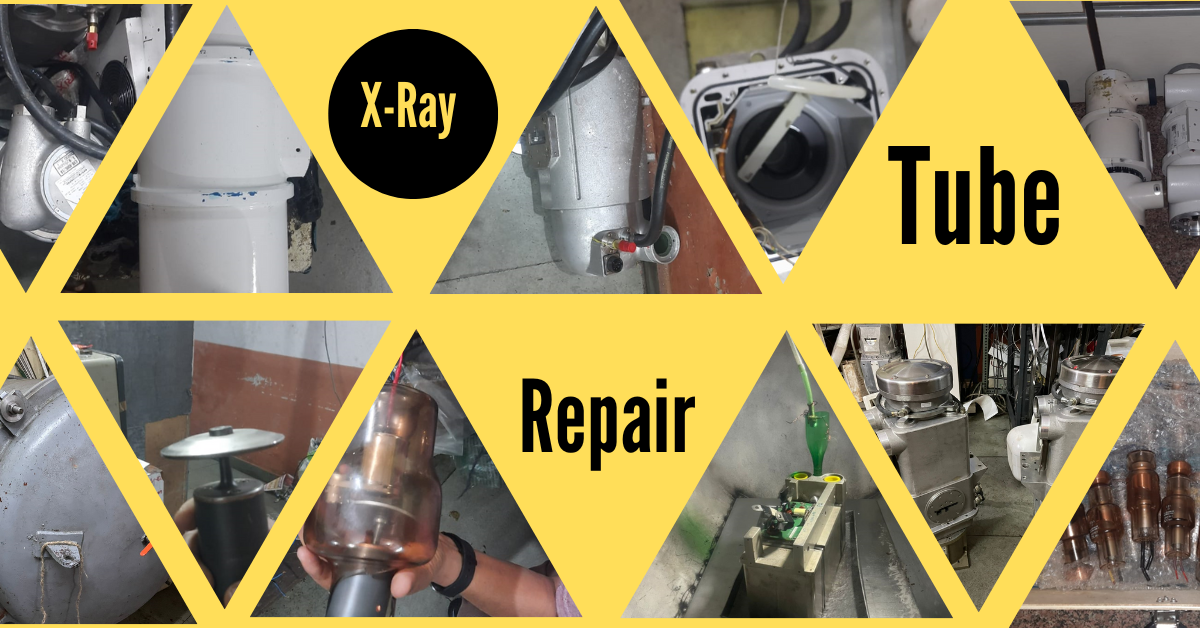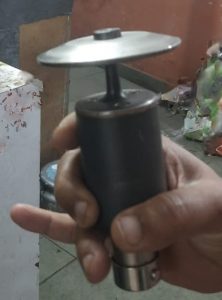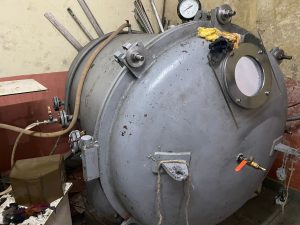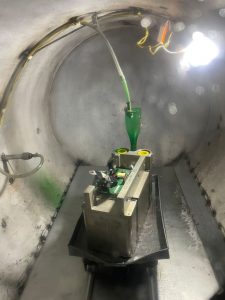
Replacing an x-ray tube can be expensive. If your x-ray tube has sustained some damage, the first thought that may occur is – Is it repairable? The most common x-ray tube repair involves replacing the oil inside the tube housing and removing any air, gases, particles that could cause arcing. This helps re-establish vacuum inside the tube and increase the strength of the insulation as well as the dielectric.
Common causes of X-Ray tube failure
Cathode filament failure, tube arcing, anode failure, Glass housing cracks/oil leak, aging of the x-ray tube components, Rotor bearing failure and x-ray filament transformer/high tension transformer failure in self-contained x-ray tube( stationary anode) are some of the common causes of x-ray tube failure.
- Cathode Filament failure – One of the significant factors that can cause the failure of an X-ray tube is extremely high voltage. Excessive and/or prolonged heating of the filament may cause breakage or vaporization of filament leading to cathode failure. The tube current, tube voltage, anode to cathode spacing, target angle and the focal spot size are some of the main factors affecting X-Ray tube characteristics. Higher the tube current, higher the filament temperature. If the filament is subjected to higher than necessary or longer than necessary tube current, the filament may start burning-out. Due to high temperatures, Tungsten may start evaporating from the filament surface in a non-uniform, spotty or patchy way – soon leading to filament breakage and failure.
- Tube Arcing – Tungsten vaporization and deposition on the inside of the glass enclosure is the most common cause of tube failure. Melting point of Tungsten used in Cathode or Anode is 34220C and hence does not vaporize easily. However, because of the immense heat load, over time, tungsten gradually vaporizes and instead of the target, deposits onto the surface of the glass envelope. This is called “Glass Crazing”. This slowly causes darkening of the surface of the glass tube. When the tungsten deposit is sufficiently thick, arcing may occur at high temperatures, when electrical current flashes from the cathode to the tungsten deposit on the glass envelope/ insulator, and then to the target, essentially causing a short-circuit. This results in a temporary loss of x-ray output, a localized artefact and/or possible damage to the glass envelope.
Other than insulator surface flashover, other common causes of arcing are – vacuum flashover due to particulate impurities or high residual gas within the tube, insulator degradation or breakdown and spurious electron emissions.
- Anode failure – In the production of X-Rays less than 1% of the energy produces useful X-rays while the remaining 99% is transformed into heat. The most frequent mode of failure of an x-ray tube is the failure to adequately dissipate the heat generated during normal operation. Tube failure could result from maintaining the anode at elevated temperatures over long exposure times. This can occur due to excessive heating during the X-ray generation without adequate cooling. Extreme heat within the housing of an X-ray tube leads to the melting of the tungsten material of the anode disc. These melted particles can interfere with the vacuum integrity within the X-ray tube, leading to its failure. Also, this may often lead to increased X-ray production and excessive vibrations of the rotor. Excessive vibration in the rotor is the primary cause of anode stem cracks as an anode disc imbalance. Anode damage can be due to bearing damage, repeated overload and exceeding maximum heat storage capacity.

- Housing cracks/ Oil Leaks – The x-ray tube lies within a metal protective housing called the tube housing. The X-ray housing prevents X-rays from being released in all directions, provide suitable high voltage insulation and allow cooling of the tube/system. Cracks in Tube Housing may lead to oil leak and further damage to the X-Ray Tube. The oil is essentially a dielectric (usually oxidization inhibited transformer oil), must provide high voltage insulation to prevent arcing from all high voltage surfaces. If oil leaks develop that usually means air has leaked in to the housing. This may cause air entering the high voltage field area and result in arcing. Some arcing in tubes and housing is common, but if arcing continues, carbon from disintegration of the oil will begin to coat surfaces. The oil used contains absorbed gasses which must be removed by vacuum treating to prevent their release in the housing.
- Aging of the X-ray tube components is an important factor responsible for the failure of the X-ray tube as old parts do not operate at their optimum level and, if left un-replaced, can lead to the failure of the X-ray tube.
- Rotor bearing failure– In rotating anode tubes, bearing failure can be an issue. All mechanical systems wear out and stop working, so the trick is to achieve longevity. High temperature and high speed will reduce bearing life the most with prolonged operation. The lubricant (which is usually silver or lead metal) wears off of the ball and raze surfaces, leaving steel-to-steel contact. This would lead to binding or jamming, abnormal sounds coming out of anode rotor and /or the rotor getting stuck.
- Self-contained x-ray-tube head contains / houses important parts like Filament transformer, High voltage transformer, Rectifier circuit, di-electric oil and x-ray tube .The transformer can fail due to failure of any of the component as discussed below:
- Windings failure: copper wire windings are the main part of a transformer. In distribution side transformers there are commonly two windings one on the primary side and the second on the secondary side. High voltage/low voltage flows in the primary side windings and through electromagnetic induction voltage is stepped down and current stepped up in the secondary winding. These windings withstand dielectric, thermal and mechanical stress during in the process. The fault occurrence in the winding are due to these stresses, this causes the breaking of the windings, the burn-out, puncture etc.,
- Transformer oil: This oil acts as an insulator and a cooling agent. There are several factors which influence transformer oil deterioration. The most significant among them is oxidation of hydrocarbons with atmospheric oxygen, high temperature and electromagnetic field.
X-Ray Tube Repair
Tube Reprocessing
Tube reprocessing involves replacing the oil inside the tube housing and removing any air, gases, particles that could cause arcing to re-establish vacuum inside the tube and increasing the strength of the insulation. This process could extend life of the tube by 20-50% more. This extra life means that a reprocessed tube could even fetch about half of a new tube cost. The tube insert remains the same.
Tube Reloading
The replacement of a new tube insert into an old housing is called reloading. A reloaded tube has its entire insert replaced with a new one in addition to being re-processed with new oil and vacuum treatment etc. For all practical purposes, life of a reloaded tube is as good as a new one and hence commands a high price accordingly.
Other type of repairs & parts replacement
As mentioned earlier,
In regular rotating anode tube housing, if faulty, the x-ray tube insert is replaced. Sometimes, the rotator coil, HT receptacles may also get defective and need replacement.
In a self-contained tube head, apart from the tube insert, Filament transformers, HT transformers, HV rectifiers are the parts that may go defective and need to be replaced.

Buying a Used X-Ray Tube?
Replacing X-Ray tubes can be an expensive affair, whether it is CT, Cathlab or any radiography system. With budgetary constraints, very often one may choose to go for a used or refurbished x-ray tube. If it is a pre-owned tube, it is good to know what type of repair, if any, has been done on the X-Ray tube.
A reseller may sell a second hand tube that has been taken out of a working machine. It may not have undergone any repair. In this case it is essential to find out how much it has been used, number of scans done, other types of repair or parts replacement that may have been done.
A used tube may come with a warranty, but only for a much shorter period of time as compared to a reprocessed or reloaded tube. One can decide how much to pay for a second hand x-ray tube based on whether insert has been replaced or oil-refilling and vacuuming has been done.
Preventing x-ray tube failure
As mentioned before tube replacement can be expensive. Therefore, it is a good idea to prevent x-ray tube failure in the first place, through following good practices while operating the X-Ray machine. Some good practices in operation and maintenance of X-Ray include:
- Warming up the anode for some time before the actual exposure. High kVp or mAs settings should never be used on a cold anode. The reason is that a sudden exposure without preheating the X-ray machine can lead to thermal shock and can cause anode failure. To avoid damage to the anode target, tube warm-ups are performed prior to any exposure if the x-ray machine has been sitting idle for more than three hours. Always warm the x-ray tube up using a low exposure settings initially and then increase step-by-step.
- Another good maintenance practice that is critical to long life of an X-ray tube is following rating charts. The tube manufacturers always provide charts, showing recommended warm-up and maximum load exposures for their tubes. Three types of x-ray tube rating charts that are important are: 1- The radiographic rating chart 2- The anode cooling chart, and 3- The housing cooling chart.
- Keep the X-ray tube, especially the window, clean – as this is the point of release for the useful radiation. A dirty window can interfere with proper exposure.
- Always try to use the lowest necessary power, the largest possible focal spot and longer exposures at reduced power rather than shorter exposures at higher power. Tube damage is reduced by such practices.
- Periodic calibration of the unit must be done.
- Need to switch off the x-ray unit when the work is over to avoid the filament failure. When the unit is ON, the filament is always glowing in pre-heat mode. Keeping it ON for long duration may cause filament failure.
X-Ray repair and X-Ray Tube Reprocessing services
Despite following good practices and maintaining your x-ray unit well – should you ever face arcing issues or other problems in the X-Ray tube, contact us! PrimedeQ can assist you with x-ray tube oil re-filling, vacuum treatment services and other types of X-Ray repair services.
—————————————————————————————————————————
PrimedeQ is an e-Marketplace for buying, selling, renting, servicing and spares of medical equipment. We offer all types of used / refurbished medical equipment , including cathlab, ECG machine and other diagnostic equipment, endoscopes, OT equipment, Laparoscopic Equipment, Lab equipment, X-Ray, TMT, anesthesia machine, ultrasound machines etc. We offer repair services for all types of medical equipment including x-ray, x-ray tube, ultrasound probe, Lab equipment, microdebrider, laparoscope , rigid and flexible endoscopes as well as EUS (Endoscopic Ultrasound Units) etc.
Contact us for any medical equipment requirements 7019759765.






